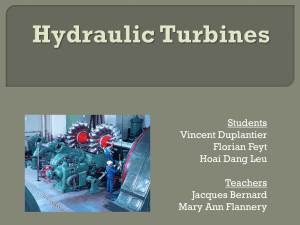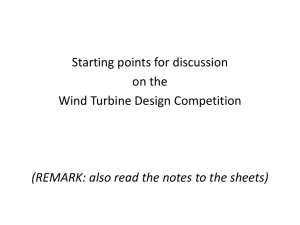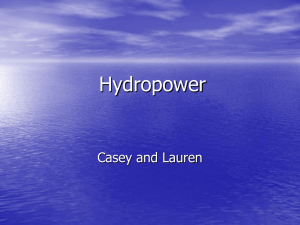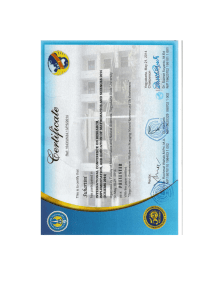Lecture 4
advertisement
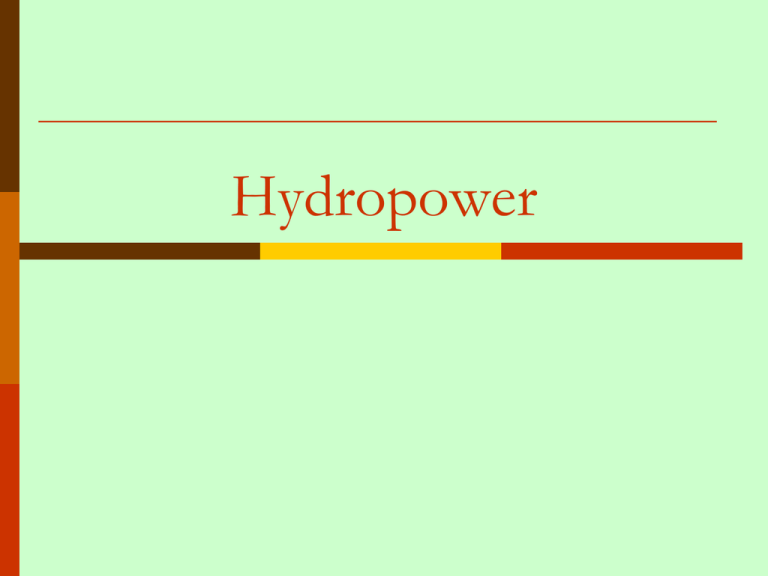
Hydropower Hydrologic Cycle Hydropower to Electric Power Electrical Energy Potential Energy Electricity Kinetic Energy Mechanical Energy Renewable Energy Sources Wisconsin Valley Improvement Company, http://www.wvic.com/hydro-facts.htm World Trends in Hydropower Major Hydropower Producers History of Hydro Power Early Irrigation Waterwheel Early Roman Water Mill Water Mill Turbine Hydropower Design Terminology Head Dams: three categories Water must fall from a higher elevation to a lower one to release its stored energy. The difference between these elevations (the water levels) is called head high-head (800 or more feet) medium-head (100 to 800 feet) low-head (less than 100 feet) Power is proportional to the product of head x flow Scale of Hydropower Projects Large-hydro Medium-hydro Above 100 kW, but below 1 MW Either stand alone schemes or more often feeding into the grid Micro-hydro 1 - 15 MW - usually feeding into a grid Mini-hydro 15 - 100 MW usually feeding a grid Small-hydro More than 100 MW feeding into a large electricity grid From 5kW up to 100 kW Usually provided power for a small community or rural industry in remote areas away from the grid. Pico-hydro From a few hundred watts up to 5kW Remote areas away from the grid. Types of Hydroelectric Installation Meeting Peak Demands Hydroelectric plants: Start easily and quickly and change power output rapidly Complement large thermal plants (coal and nuclear), which are most efficient in serving base power loads. Save millions of barrels of oil Types of Systems Impoundment Diversion or run-of-river systems Hoover Dam e.g. Grand Coulee Niagara Falls Most significantly smaller Pumped Storage Two way flow Pumped up to a storage reservoir and returned to a lower elevation for power generation A mechanism for energy storage, not net energy production Conventional Impoundment Dam Example Hoover Dam (US) Diversion (Run-of-River) Hydropower Example Diversion Hydropower (Alaska) Micro Run-of-River Hydropower Used in remote locations in northern Canada Pumped Storage System Example Cabin Creek Pumped Hydro (Colorado) Completed 1967 Capacity – 324 MW Two 162 MW units Purpose – energy storage Water pumped uphill at night Water flows downhill during day/peak periods Helps to meet surge demand Low usage – excess base load capacity E.g., air conditioning demand on hot summer days Typical efficiency of 70 – 85% Turbine Design Francis Turbine Kaplan Turbine Pelton Turbine Turgo Turbine New Designs Types of Hydropower Turbines Classification of Hydro Turbines Reaction Turbines Derive power from pressure drop across turbine changes pressure as it moves through the turbine and gives up its energy Totally immersed in water Angular & linear motion converted to shaft power Propeller, Francis, and Kaplan turbines Impulse Turbines Convert kinetic energy of water jet hitting buckets impulse turbines change velocity of a water jet No pressure drop across turbines Pelton, Turgo, and crossflow turbines I = FΔt = mΔv =Δp Schematic of Francis Turbine Boyle, Renewable Energy, 2nd edition, Oxford University Press, 2003 Francis Turbine Cross-Section Kaplan Turbine Schematic Kaplan Turbine Cross Section Pelton Wheel Turbine Turgo Turbine Turbine Design Ranges Kaplan Francis Pelton Turgo 2 < H < 40 10 < H < 350 50 < H < 1300 50 < H < 250 (H = head in meters) Turbine Ranges of Application Boyle, Renewable Energy, 2nd edition, Oxford University Press, 2003 Turbine Design Recommendations Head Pressure Impulse Reaction High Medium Low Pelton Turgo Multi-jet Pelton Crossflow Turgo Multi-jet Pelton Crossflow Francis Pump-as-Turbine Propeller Kaplan Fish Friendly Turbine Design Hydro Power Calculations Efficiency of Hydropower Plants Hydropower is very efficient Typical losses are due to Frictional drag and turbulence of flow Friction and magnetic losses in turbine & generator Overall efficiency ranges from 75-95% Hydropower Calculations P g Q H P 10 Q H P = power in kilowatts (kW) g = gravitational acceleration (9.81 m/s2) = turbo-generator efficiency (0<n<1) Q = quantity of water flowing (m3/sec) H = effective head (m) Economics of Hydropower Production Expense Comparison Environmental Impacts Ecological Impacts Loss of forests, wildlife habitat, species Degradation of upstream catchment areas due to inundation of reservoir area Rotting vegetation also emits greenhouse gases Loss of aquatic biodiversity, fisheries, other downstream services Cumulative impacts on water quality, natural flooding Disrupt transfer of energy, sediment, nutrients Sedimentation reduces reservoir life, erodes turbines Creation of new wetland habitat Fishing and recreational opportunities provided by new reservoirs Environmental and Social Issues Land use – inundation and displacement of people Impacts on natural hydrology Impacts on biodiversity Increase evaporative losses Altering river flows and natural flooding cycles Sedimentation/silting Aquatic ecology, fish, plants, mammals Water chemistry changes Mercury, nitrates, oxygen Bacterial and viral infections Tropics Seismic Risks Structural dam failure risks Hydropower – Pros and Cons Positive Negative Emissions-free, with virtually no CO2, NOX, SOX, hydrocarbons, or particulates Frequently involves impoundment of large amounts of water with loss of habitat due to land inundation Renewable resource with high conversion efficiency to electricity (80+%) Variable output – dependent on rainfall and snowfall Dispatchable with storage capacity Impacts on river flows and aquatic ecology, including fish migration and oxygen depletion Usable for base load, peaking and pumped storage applications Social impacts of displacing indigenous people Scalable from 10 KW to 20,000 MW Health impacts in developing countries Low operating and maintenance costs High initial capital costs Long lifetimes Long lead time in construction of large projects Other Agencies Involved FERC – Federal Energy Regulatory Comm. Ensures compliance with environmental law IWRM – Integrated Water & Rsrc Mgmt “Social and economic development is inextricably linked to both water and energy. The key challenge for the 21st century is to expand access to both for a rapidly increasing human population, while simultaneously addressing the negative social and environmental impacts.” (IWRM) Summary of Future of Hydropower Untapped U.S. water energy resources are immense Water energy has superior attributes compared to other renewables: Water energy will be more competitive in the future because of: Nationwide accessibility to resources with significant power potential Higher availability = larger capacity factor Small footprint and low visual impact for same capacity More streamlined licensing Higher fuel costs Green energy mandates, carbon credits New technologies and innovative deployment configurations Significant added capacity is available at competitive unit costs Changing hydropower’s image will be a key predictor of future development trends





